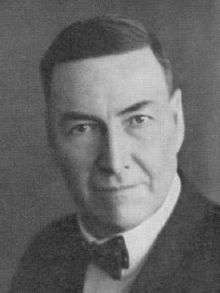Parker Moloney
| The Honourable Parker Moloney | |
|---|---|
 | |
| Member of the Australian Parliament for Indi | |
|
In office 13 April 1910 – 31 May 1913 | |
| Preceded by | Joseph Brown |
| Succeeded by | Cornelius Ahern |
|
In office 5 September 1914 – 5 May 1917 | |
| Preceded by | Cornelius Ahern |
| Succeeded by | John Leckie |
| Member of the Australian Parliament for Hume | |
|
In office 13 December 1919 – 19 December 1931 | |
| Preceded by | Franc Falkiner |
| Succeeded by | Thomas Collins |
| Personal details | |
| Born |
12 August 1879 Port Fairy, Victoria |
| Died |
8 May 1961 (aged 81) Victoria |
| Nationality | Australian |
| Political party | Australian Labor Party |
| Spouse(s) | Margaret Mary Mills |
| Occupation | Teacher |
Parker John Moloney (12 August 1879 – 8 May 1961) was an Australian politician, teacher and public servant. He was born at Port Fairy, Victoria to Maurice Moloney and Mary, née Bowe. He became a teacher at John O'Hara's South Melbourne College in 1902 and then at University High School. Around this time he began to be interested in Labor politics and attended the Catholic Young Men's Association. In 1906 he became principal of Beechworth College.
In 1910 Moloney won the Victorian seat of Indi for Labor. He lost it in 1913, but regained it in 1914, in which year, on 15 April, he was married to Margaret Mary Mills. However, it was his opposition to conscription which lost him the seat for good in 1917. He relocated to New South Wales and in 1919 became the first Labor representative for Hume. Despite representing a New South Wales seat, he continued to live in Melbourne, but built up a strong support base in Hume. He was one of only a small number of people who have represented more than one state or territory in the Parliament.
Moloney was Minister for Markets and Transport from 1929 to 1931 as part of the Scullin government. He negotiated Australia's first trade treaty with Canada, and was rewarded with a parliamentary ovation. Despite many continuing exploits, including preparing for the Imperial Economic Conference of 1932, to be held at Ottawa, Canada, Moloney lost his seat in the conservative landslide of 1931.
There were no parliamentary pensions, which left Moloney almost destitute. He sold his house and moved in with his aunt. With former colleague Richard Keane, he managed to buy two old mining dumps near Bendigo, which were sold to Collins House for ₤3000. He also became active in the share market. By 1939 he was president of the Australian Labor Party in Victoria, but, despite two unsuccessful Senate campaigns, he withdrew from politics in 1943, when Labor won office. He gradually moved away from the ALP and joined the Democratic Labor Party. Chairman of the Victorian Dried Fruits Board from 1936–1957, he was only able to retire after Prime Minister Robert Menzies ensured he would be provided with a pension. He was closely associated with Archbishop Daniel Mannix, and was always interested in horse-racing.
Moloney died on 8 May 1961 and was given a state funeral. He was remembered by Archbishop Guilford Young as "outstanding among a great generation of Catholic men who had a special Catholic ethos".
References
- Lloyd, C. J. (1986). "Moloney, Parker John (1879–1961)". Australian Dictionary of Biography. Canberra: Australian National University. Retrieved 25 August 2007.
| Political offices | ||
|---|---|---|
| Preceded by Thomas Paterson |
Minister for Markets and Transport 1929–31 |
Succeeded by Archdale Parkhill |
| Parliament of Australia | ||
| Preceded by Joseph Brown |
Member for Indi 1910–13 |
Succeeded by Cornelius Ahern |
| Preceded by Cornelius Ahern |
Member for Indi 1914–17 |
Succeeded by John Leckie |
| Preceded by Franc Falkiner |
Member for Hume 1919–31 |
Succeeded by Thomas Collins |